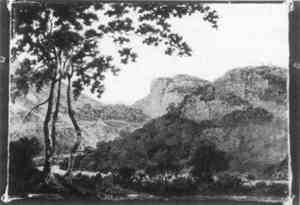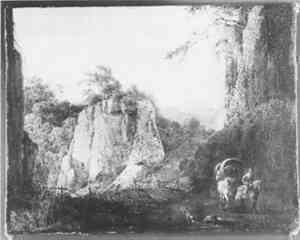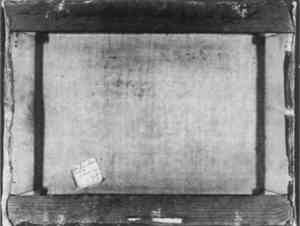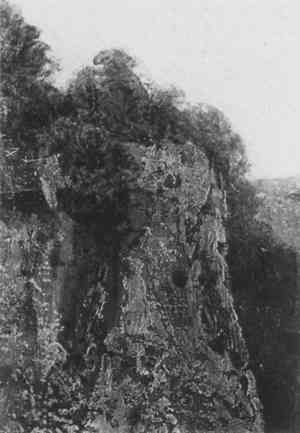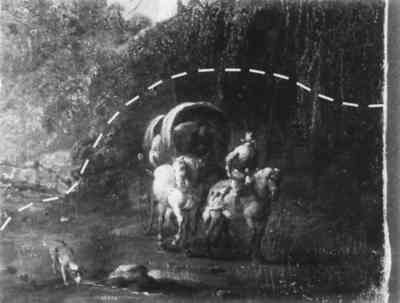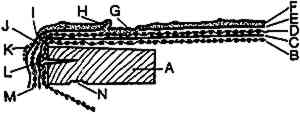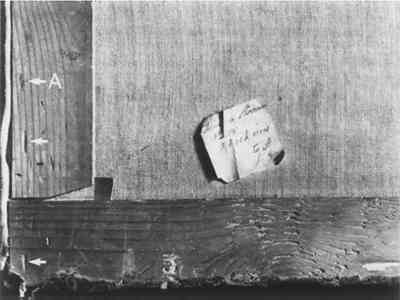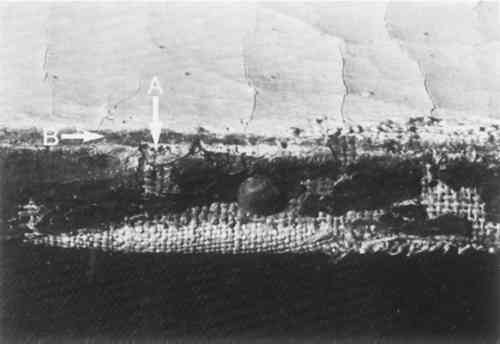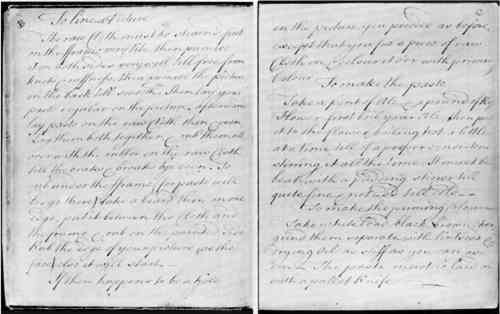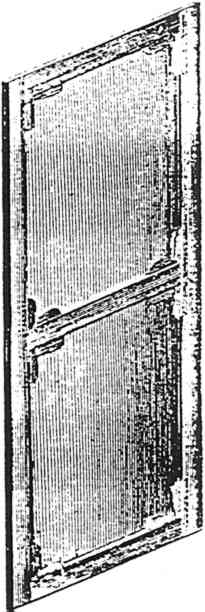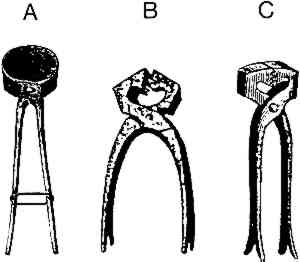AN 18TH-CENTURY ARTIST-APPLIED LINING: JOSEPH WRIGHT OF DERBY'S CUT THROUGH THE ROCK AT CROMFORDIAN S. HODKINSON, & DEBORAH M. CHILD
ABSTRACT—Recent investigation of a group of eight landscape paintings, owned by the Agnes Etherington Art Centre, Queen's University, Kingston, Canada, and attributed to British artist Joseph Wright of Derby (1734–97), has yielded considerable information about both painting and restoration techniques of the 18th century. The authors examine and compare in depth both paintings, one that is typical of Wright's work and one that appears to include a fragment of another artist's painting. The authors then discuss various unusual aspects of the second painting, including the sophisticated expandable stretcher. 1 INTRODUCTIONIn 1988 the Agnes Etherington Art Centre of Queen's University at Kingston, Canada, acquired eight small paintings attributed to the British artist Joseph Wright of Derby (1734–97) (Nicolson 1968). Seven of the paintings are oil on canvas, while one is oil on paper. They are a fascinating group both art historically and technically since their conservation represents the whole gamut of degrees of later intervention, from nothing at all to complete treatment involving varnish removal, lining, retouching, and revarnishing. Wright left some notations about his working methods and materials, which made possible further interpretation of these works (Wright 18th c.).1 The group of paintings became the object of a combined art-historical and technical examination that resulted in many interesting observations (Brown 1990). The timing of the acquisition happily coincided with the mounting of the Tate Gallery's exhibition Wright of Derby and the publication of a comprehensive exhibition catalog (Egerton 1990) with an excellent technical section (Jones 1990). Two of the paintings are of special interest to the conservator and to the study of historical painting techniques, because neither has been changed by later intervention and thus, except for the inevitable effects of age, they appear just as they did when they left the artist's studio. In addition, for the primary support of Cut through the Rock at Cromford, the evidence points to the fact that Wright apparently used a fragment of an old discarded painting by another hand, lined it, and used it for his own painting, leaving in the bottom right corner a group of figures from the earlier work visible as part of the composition of the finished painting. The two paintings concerned are Derwent Valley, Derbyshire(figs. 1, 2)2, and Cut through the Rock at Cromford(figs. 3, 4), hereafter referred to as Derwent and Cromford. Cromford, the lined painting, is the main focus of this study, but Derwent will also be described as it makes an interesting comparison with its unorthodox companion and complements other published studies on early untouched paintings by Wright of Derby and others (Wyld and Thomas 1986, Bomford 1979, Massing and Groen 1988).
2 ATTRIBUTION AND PROVENANCEThe Derwent picture is not signed, but during this study a monogram was discovered on the Cromford painting. They both bear the unmistakable stylistic “signature” of Wright of Derby. The choice of palette, the vigorous application of textured paint using both brush The site of the Derwent painting can be identified by the presence of the famous landmark Matlock Tor in the background. Matlock was a popular site for landscape painters and Wright executed a number of paintings of it. They include two scenes of Matlock Tor by moonlight (Matlock Tor, Moonlight, Yale Center for British Art, Paul Mellon Collection [Nicolson 1968, cat. no. 308] and Matlock Tor, Moonlight, Detroit Art Institute [Nicolson 1968, cat. no. 309]; one by daylight (Fitzwilliam Museum, Cambridge [Nicolson 1968, cat. no. 111; see also Egerton 1990, 184]) that has a similar composition to the Queen's University painting; and Landscape with Figures and a Tilted Cart: Matlock High Tor in the Distance (Southampton City Art Gallery Collection; see Egerton 1990, 193), which is taken from almost the same vantage point. The Cromford painting is based on a site in Cromford, Derbyshire, that can still be identified, although the artist has taken some liberties with the topography. The cut through the rock referred to in the title is Scarthin Nick, a massive stone outcropping that occupies the left half of the picture. The view is taken from a vantage point with Cromford Village directly behind. The road in the painting is now the A-6 motorway. Due to the creation of this motorway, the high feature to the right is now less prominent than it appears in the painting. The scene is actually a composite view, and by placing Scarthin Nick in the middle distance rather than the foreground where it should be located, the artist gives the viewer a sense of structure and order typical of the kind of classical landscape composition he practiced. The inclusion of a horse-drawn wagon, two figures, and a dog in the right foreground recalls the naturalistic landscapes of 17th-century Holland. Wright executed at least four other views of the Cromford area. All included horses and wagons, usually with direct reference to Arkwright's Cotton Mills, built between 1771 and 1777, but the wagon type is quite different. The work is inscribed on the back of the stretcher in dark brown ink: Cut Through the Rock at Cromford by Joseph Wright, and an inventory label adhered to the back of the canvas is a complete version of the fragment on Derwent. The label reads: “Dining Room No. 18. A Rockview” and has the initials “C. A.” and “J. G.” (see also fig. 8), referring to the executors of the estate of John Holland (1734–1807), Wright's close friend. According to the Wright files kept in the Derby Art Gallery, this is the painting referred to by Wright in his letter to John Holland: The letter is inscribed on the back in Holland's handwriting: “Received October 10th, 1795 by J. H.” It is in the collection of William Dale of London, Ontario, who acquired it at the same time as he purchased the painting.
Although this inscription provides a terminus date, the style and technique used in painting the landscape suggest an earlier date of 1770–73 when “Wright particularly favoured—a fairly lavish use of paint which is then overlaid with glistening dribbles of impasto, which in its turn is scuffed and scratched to give a lichenous scaly effect” (fig. 5) (Egerton 1990, 75). While this observation is true of the landscape, the same cannot be said for the staffage group at the right (fig. 6). On the contrary, the style and technique are different. In this area the use of paint is much more delicate. It is applied quite thinly
Ultraviolet, infrared, and x-radiography were used to attempt to understand the relationship of the anomalous figure group to the rest of the painting. Unfortunately, these examination techniques provided no clues. Reasoning had to be based on other technical information allied to historical studies. There are several possible reasons for the existence of such a stylistic and technical anomaly in a painting. One cause could be that the picture is a result of a conscious collaborative effort between two artists, one painting the landscape and the other the figures. The use of “auxiliaries” is known in the period. Thomas Jones (1742–1803), a pupil of Richard Wilson, recounts such an effort in his Memoirs:
In addition to providing landscapes, Wright's contemporaries were also engaged to execute figures and animals for landscapes painted by other artists. Sawrey Gilpin (1733–1807), for instance, painted the horses and figures in the elder George Barrett's Llyn Peris of 1777 (Nottingham Museum and Art Gallery; see Constable 1954, pl. 155a). However, such an explanation for the Cromford painting is unlikely since there is no evidence in the considerable body of information we have about Wright that he worked as an auxiliary or engaged other artists for such a purpose. A more plausible explanation could be that Wright used one of his own earlier canvases. An example of this practice recently turned up when his Lake by Moonlight in the Paul Mellon Collection was radiographed to reveal an underlying portrait of a middle-aged man (Nicolson 1988). Wright was also known to “cook up” his own earlier unfinished works. In a letter of 1792 to one of his patrons, J. L. Philips, he remarked: “I have sent off by shawcross … and a slight sketch of a wild scene painted some years ago. I cooked it up the other day” (Wright 1792). However, this argument is refuted by the clear technical evidence (to be described later) 3 TECHNICAL ANALYSESAlthough the focus of this study is Cromford, the technical analysis of Derwent will be discussed first, as it is more typical of Wright's painting practices and therefore highlights the unusual characteristics of the other work. 3.1 DERWENT3.1.1 AUXILIARY SUPPORT, WOOD STRAINERDerwent is supported on a wooden strainer (i.e., a stretching frame with fixed corner joints), consisting of four members made of pine with a cross section, 11 � 32 mm, chamfered on the inner edge. (Fixed-joint stretchers are often referred to as “strainers,” but this seems a dubious distinction since the action of keying out a painting on a stretcher with expandable joints would actually put more “strain” on the painting in the mechanical sense.) They are joined at the corners, slightly off the square, with half-lap joints glued with animal glue and nailed with hand-forged nails clinched on the side toward the canvas (Neve 1726). This method seems typical of the period and would conform to the shape of the profile on the back of Mr. and Mrs. Coltman as described by Wyld and Thomas (1986). It is also in the same form as the original strainer on an oil sketch of Hector's Farewell to Andromache (oil on canvas, 32.5 � 45.5 cm) by Gavin Hamilton, dated on the back 1792, in the Collection of I. Hodkinson. One refinement that Wright practiced was to cover the clinched ends of the nails with what appears to be a white lead putty to prevent their corrosion from affecting the canvas. The putty was first noticed in a radiograph and confirmed by removing the tacks at one corner and peering in. 3.1.2 ATTACHMENT OF CANVASThe tacks employed to attach the canvas to the stretcher are also of hand-forged iron and are approximately 7.5 mm long. The shapes of the heads vary. Some are irregularly shaped, and some have round heads similar to those used by upholsterers. They are of the type known as “white tacks,” that is, they were tinned to prevent corrosion (Neve 1726). The intervals between the tacks vary slightly, the average being 4.6 cm. The disposition of the 3.1.3 PRIMARY SUPPORT, CANVASThe canvas is in reasonably good condition, and while not floppy, it is not under tension on the stretcher. It is of linen 1 � 2 twill and has a selvage along the bottom, while the other three edges are cut. The average thread count is approximately 20 per cm vertical (i.e., weft) by 15 per cm horizontal (warp). The wale runs diagonally from bottom left to top right. The threads are irregularly spun, and although the weave is fairly tight, where there are adjacent thin threads there are open interestices visible from the back. 3.1.4 PREPARATION AND GROUNDThrough these interstics it is possible to see the sizing and ground. The sizing is of sufficient quantity to bridge the gaps and prevent the ground from penetrating the interstices. It is apparent that the canvas was sized and grounded in a larger piece of which this is only a section. At the selvage the ground does not continue to the very edge, and there are other tack holes with corresponding marked cusping. On the other three edges the ground continues right to the cut edges, and no cusping is visible. A sample cross section of ground and paint layers was mounted and examined, and a smooth, creamy white ground containing some larger translucent particles was noted similar to those illustrated by Jones (1990). 3.1.5 UNDERDRAWINGOn visual examination, there appeared to be graphite delineation of the mountain contour. The presence of underdrawing was confirmed by infrared vidicon examination. Of the 50 Wright paintings examined by Jones (1991a), underdrawing was visible in only one work: View in Matlock Dale(Egerton 1990). As both paintings are of the same local scene, perhaps Wright began them both plein air using graphite directly on the prepared canvas. 3.1.6 PAINT LAYERSThe painting was done after the canvas was mounted on the stretcher, as the strokes of paint seen on some tack heads are of the same color as the adjacent painting where the brush hairs have gone partly over the edge. The cross-section examination confirms that the dead coloring is noticeable under the landscape. The paint application is vigorous but controlled. Both finger and brush have been used in creating the heavier texture on the sky. Ultraviolet examination shows that a grayish glaze was applied between the trees and the contours of the mountain to mute the brightness of the sky while giving it luminosity and re-establishing recession in space. The fine craquelure relates more to the weave geometry of the canvas than to stresses induced by tension from stretching. 3.1.7 SURFACE COATINGThere is a surface coating on the painting, but because of significant differences in crackle pattern between the varnish and the painting it is believed that it is not artist-applied. 3.2 CROMFORDTo assist in understanding the structure a cross-sectional diagram is shown in figure 7.
3.2.1 AUXILIARY SUPPORT, WOOD STRETCHERThe four-membered stretcher is quite sophisticated. It is made of pine, each member approximately 6.0 cm wide and 1.4 cm thick at the perimeter. There is a slight overall bevel, the inner edge being 2–3 mm thinner. Of the three original stretchers identified by Jones (1991a), two of them are similar in design, but no description was given of the type of corner joint. The corner joints on Cromford are of an expandable, mortise-and-tenon type, with the tenons of haunched design to minimize warping and slitting (fig. 7) and with provision for
3.2.2 SECONDARY CANVAS SUPPORT AND ATTACHMENTThe painting is lined on a linen canvas having a thread count of 12.5 per cm (horizontal) and 16 per cm (vertical). This lining fabric is attached to the stretcher with tacks independently from the primary canvas support (i.e., the tacks are under the tacking edge of the painting), indicating that it was on the stretcher prior to adhering the painting. The tinned tacks are of the same type as those used for attachment of the painting and are similar to those noted above on Derwent but with a higher proportion of the round-headed variety. The adhesive is of a paste type and has a light grayish white appearance. It tests strongly for starch with the iodine/potassium iodide test (Browning 1977). Tests for protein were inconclusive when using fluorochrome stains (Wolbers and Landrey 1987). Subsequent instrumental analysis with Fourier transform infrared spectroscopy (FTIR) confirmed that it is a starch and protein adhesive (Moffat and Miller 1991). 3.2.3 PRIMARY CANVAS SUPPORT AND ATTACHMENTThis plain-weave, flax canvas has a thread count of 10.5 � 10.5 threads per cm. The canvas is brown and brittle, much more so than any of the other six canvases in the Queen's University group. There is an unpainted tacking edge at the right, but the other three edges show that it has been cut from a larger, already painted canvas. The tacks used to attach this canvas are the same as those employed on the lining canvas. 3.2.4 PREPARATION AND GROUNDSince the painting is lined it is difficult to determine if the canvas was sized, but normal practice would suggest so. Cross-section examination shows that the ground is substantial, with a dull pink color and finely ground pigments. A pink ground is unusual for Wright. The other indisputable Wrights in the Queen's University group all have creamy white grounds of the same general type as shown in the seven cross sections illustrated by Jones (1990). Of the 50 Wright paintings Jones examined in preparation for the technical section of the Tate exhibition, 14 of which were cross sectioned, only two were found to have pink grounds: the Portrait of Brooke Boothby dating from 1781 and Cottage on Fire, c. 1790, in the Derby Art Gallery (Jones 1991b). The density of the ground in the radiograph suggests a high lead white content, which unfortunately also prevented any further interpretation concerning the earlier composition. At the top left quadrant the ground has flaked considerably, to the extent that in two places the canvas is covered only by the paint of the later painting. Flakes of ground and paint are embedded in the new paint, indicating that the damage was present when Wright's sky color was applied. 3.2.5 PAINT LAYERSAs noted above, this painting was completed over a fragment of an earlier composition. Thus, there are two quite distinct stratifications present. The earliest consists of thin layers that were applied with quite fluid paint in a generally reddish brown hue no doubt influenced by the color of the ground. This earliest presentation surface is visible not only at the bottom right corner encompassing the figure group but also on the bottom, top, and left tacking edges. The right edge corresponds with the present edge and, to judge from the cusping, the bottom seems to have been displaced by perhaps only a centimeter. However, there are no indications at the left and top of the dimensions of the earlier work. The second paint layer system is that of Wright. Since it lies only on the front surface and was not intended to carry around onto the tacking margins, it was definitely applied after the canvas was lined and mounted on its stretcher. The painting has remained undisturbed on this stretcher since it left Wright's hand. This is clearly shown by the presence of traces of Wright's paint on the tacking edges, where some of the bristles of his brush went over the edge and inadvertently deposited paint where the round-headed tacks of the lining canvas have caused bulges in the earlier paint surface on the tacking margin (fig. 10). X-radiography revealed that craquelure exists in the earlier paint layers but is not visible on the surface. At the top left, Wright's sky color penetrates some of these cracks. Therefore, the earlier painting was considerably aged and damaged before Wright used it.
4 INTERPRETATION OF TECHNICAL OBSERVATIONSPreliminary observations that the Cromford painting was lined and on a keyed stretcher led to the immediate assumption that the lining was a later intervention. Further exhaustive scrutiny has shown that assumption to be wrong. The evidence is undeniable that the painting presently visible was lined before its completion and has not been altered structurally since. The lining is therefore of the late 18th century and must have been done either by someone for Joseph Wright or by Wright himself. That Wright did it himself is quite feasible. He would have witnessed restoration practices between 1751 and 1753 when he was apprenticed to Thomas Hudson (1701–79) at a time when Hudson was still providing this service (Miles 1979). In Wright's Account Book (Wright [18th c.]) there are notations about his restoration work. For example:
Furthermore, in a section of the Account Book headed To Line a Picture, the instructions describe exactly the method and materials used on the Cromford painting (fig. 11).
A sample of the “priming colour” taken from the filling used to compensate a loss in a restored area on the canvas was tested by Analytic Services, Canadian Conservation Institute. It was found to be composed primarily of calcium carbonate and lead white mixed with a minor amount of clay and iron oxide in a linseed oil medium. Therefore, it differs somewhat from Wright's recipe in that it contains calcium carbonate as well as lead white, “earth colors,” and The method Wright describes calls for the lining canvas to be tacked to the stretcher before attaching the painting. After the lining canvas is stretched, the paste is applied to it and to the back of the painting. Then the two adhesive-coated surfaces are brought into contact. A second set of tacks is then used to attach the painting to the stretcher. To experiment with the procedure, the authors lined a fragment of an old painting used in the laboratory for experimental purposes. The process was fast, easy, and worked remarkably well, although, as with any aqueous adhesive system, it would be very dangerous on canvases prone to shrinkage on contact with water. As instructed, the lining canvas was tightly stretched. A keyed and beveled stretcher was employed. Thereafter, both sides were sand-papered, as was the back of the painting, now detached from its stretcher in preparation for receiving the paste. The composition of the paste is interesting. The infrared spectra of the lining adhesive from the painting and of the experimental paste were almost identical (Moffat and Miller 1991). Jones (1991a) speculates that ale was chosen for its preservative properties. This choice seems unlikely, as the paste made in the lab grew mold after three days. A more plausible explanation is that ale gives tack, and presumably the sugars present have a long-term humectant effect. For the experiment the paste was made using ale obtained from a small private brew house (Kingston Brewing Company, Clarence Street, Kingston, Canada) that uses methods similar to those employed in the 18th century with no preservatives or other additives. Quantities were converted to metric; 568 ml of boiling ale were added to 454 g of the flour in a pudding basin and beaten with a wooden spoon. Wright's instruction, “till of a proper consistence” was difficult to interpret, but clearly one pint of ale was not enough to slake the thirst of one pound of flour. Perhaps the modern rye flour was too finely ground. To make a spreadable paste, another 200 ml of ale had to be added. The resulting paste was of a consistency similar to that used for traditional pasta linings. It also gave a clue to the meaning of “lay your paste regular on the surface.” It was applied in a thin, even layer with a spatula. Applying it first to the back of the painting had the effect of allowing time for moisture to penetrate the paint layers and plasticize them before applying pressure. As expected, the lining canvas tightened when the paste was applied. Since the lining canvas used in the experiment was machine-woven, it probably tightened more than the hand-woven lining canvas used on the Cromford painting. It was assumed that the “rubber” Wright used to apply pressure was some kind of padded fabric ball. A makeshift one was made by wrapping a wad of cotton batting in a piece of cloth. It was perhaps a little soft to press out the paste and distribute it evenly between the adhering surfaces. A somewhat harder material would have served better. The technique of using “a board thinned on one edge to press under the frame” also worked comparatively well and demonstrated the need for a well-beveled stretcher. Rubbing on the painted surface as per Wright's instructions could also account for the damages present on the Cromford at the top left edge. During the rubbing procedure the whole system became slacker on the stretcher, but after drying it tightened up acceptably, presumably because of paste shrinkage. All in all, the procedure was easy, efficient, and amazingly effective. Having established that the process described by Wright could yield a result identical to that on the Cromford painting, other questions then Contemporary English sources give little detailed information on the subject, but Diderot's Encyclopedia (1751–80) is helpful. In the section on the craft of the painter are illustrated examples of stretchers, including a ch�sis � clefs(fig. 12) (vol. 29, pl. 4, fig. 2 and pl. 5, fig. 5).4 In the section on carpentry (vol. 28, pls. 1,2) are illustrated several corner joints similar to, though not exactly the same as, the Wright stretcher. Wright's use of such a stretcher thus is not out of the question, and indeed Jones illustrates a stretcher of this type although she does not specify the exact type of corner joint (Jones 1991a).
The evidence of stretching pliers is more surprising. They are not mentioned in Wright's Account Book instructions, and Gettens and Stout (1966, 284–86) state that “this tool is mentioned in catalogs of 1899 and times since then. It is not noticed earlier or referred to in earlier literature on painting practice.” According to Carlyle, the records of the art supply company Roberson's of London introduced “straining pincers,” subsequently called “canvas pliers,” beginning in 1884 (Carlyle 1991, 257–69). However, evidence that such pliers existed even earlier and were used in Wright's time is contained in Diderot, although not in the context of the painter. In volume 12 there are at least 12 entries under the heading of “Pinces,” and there are several illustrations of such devices designed for various purposes (fig. 13). The most likely craft from which the artist would
5 CONCLUSIONSTechnical evidence obtained during the course of this investigation confirms that the lining of the Cromford preceded the completion of the painting presently visible, and the work has not been structurally altered since then. The methods and materials used thus predate Wright's death in 1797 and, to judge from the landscape style, probably date from about 25 years earlier. The remarkably good condition of the old lining and the success of an experimental lining carried out according to the instructions cited in Wright's Account Book demonstrate it to be a viable procedure. To obtain control of canvas tautness, Wright selected a sophisticated expandable mortise-and-tenon type stretcher frame perhaps not normally used on his own small paintings. (Only five stretchers have been identified in the literature as being original to the Wright paintings to which they are attached, so it is not possible to assess what type of stretcher the artist preferred.) Moreover, the marking left by the application of stretching pliers during lining confirm that such pliers were used by artists, at least in a restoration context, more than 100 years earlier than previously reported. Wright's expropriation of a fragment of another artist's work raises interesting and as yet unanswered art-historical questions. Why did Wright do it? Was it a unique occurrence, specifically for Wright and indeed for artists of the period in general? Who painted the earlier fragment? In the case of Cromford, Wright was not reusing one of his own canvases, nor was he acting as a restorer. As he was financially comfortable and had no economic need to recycle old canvases, the most likely motivation was that the saw an otherwise unusable fragment he admired and could not bear to see it consigned to oblivion. This impulse could perhaps explain why he would embark on the time-consuming task of lining a fragile, brittle, and damaged canvas, carefully preserving the portion that was salvageable. From the fine rendition of the horses, wagon, and dog, and especially the expert fore-shortening in the anomalous figure group, it is apparent that the earlier artist was a considerable master. Further connoisseurial inquiry identifying the style of execution, the costume, and the type of horses and wagon might assist with identification of this artist. Cross-section studies reveal that different working methods and palette were used in the execution of the underlying work. Further comparative instrumental analysis might yield more information to help determine when, where, and by whom it was executed. Recent identification of the blue pigment in the undisturbed area of the canvas as Prussian blue at least confirms the earlier work was not created before 1704 (Moffat and Miller 1991). The origin of the earlier painting could be interesting with regard to Wright studies, as his artistic influences continue to be the subject of scholarly debate. Although Wright openly acknowledged his admiration for Richard Wilson's classical landscapes, both verbally and in copies, the prototypes he utilized in the execution of his rustic landscapes remain uncertain. Nicolson (1968) suggested that he was influenced by Dutch art of the previous century, a thesis that has not been supported by later Wright scholars. Nicolson cites the Utrecht school as Wright's favorite school of painting and repeatedly refers to the impact of the Dutch Romanists and the Dutch Caravaggists on Wright's work. Egerton (1990) apparently With regard to restoration and conservation treatment of these two paintings, it has been recommended to the Agnes Etherington Art Center that they be stabilized but given minimal treatment to preserve all the features that are of such importance to the study of the history of art and conservation technology. ACKNOWLEDGEMENTSThe authors would like to thank Alfred and Isabel Bader and the Government of Canada for their generous assistance in acquiring the group of Wright paintings; the Queen's University Advisory Research Committee for providing the funding to make technical examination of the eight paintings possible; Ron Irvine for his assistance with the illustrations, Elizabeth Moffat and David Miller of the Analytical Research Service, Canadian Conservation Institute, for pigment and media analysis; the National Portrait Gallery, London, for permission to publish pages from Wright's Account Book; and Rica Jones of the Tate Gallery for her generous cooperation. NOTES1. Nicolson (1968) refers to this document as Wright's Account Book, presumably because it contains listings of landscapes as well as portraits, information about prices of pictures, sundry bills paid, and monies received. It is more than just an account book, however, as it also contains information about materials and methods, such as “The Contents of Ye Pallet” and “To Line a Picture.” It is unfortunate that there are no dates indicated in the entries and that the pages seem to have been rearranged when they were rebound, probably sometime in the early 19th century (see also Egerton 1990). 2. Derbyshire historian Gladwyn Turbutt suggests that as the painting represents High Tor, Matlock, the scene can be more accurately identified as the Derwent Valley, Derbyshire, rather than just River Valley, (?Derbyshire) as Nicolson (1968) had cataloged it (Turbutt 1991). Brown (1990) titled it Dovedale Valley, Derbyshire, on the basis of an old exhibition label on the back. 3. This sentence remains unfinished in Wright's text. It seems likely that he is instructing the operative to be sure the tacking edges are well stuck down. The sentence should read something like: “Rub the edge of your picture (as the face) else it will start to separate.” REFERENCESBomford, D.1979. Moroni's Canon Ludovico di Terzi: An unlined 16th-century painting, National Gallery Technical Bulletin3:36–41.
Brown, D. M.1990. A question of attribution: Eight British landscape paintings given to Joseph Wright of Derby (1734–1797) in the Queen's University Art Browning, B. L.1977. Analysis of paper. 2d ed.New York: Marcel Dekker. Carlyle, L.1991. A critical analysis of artist's handbooks, manuals and treatises on oil painting published in Britain between 1800–1900: With reference to selected 18th-century sources. Ph.D. diss., Courtauld Institute of Art, London. Constable, W. G.1954. Richard Wilson. London: Routledge and Kegan Paul. Diderot, D., and J. L.d'Alembert. 1751–80. Encyclop�die, ou, Dictionnaire raisonn� des sciences, des arts et des metiers, 1st ed.Paris: Briasson. Egerton, J.1990. Wright of Derby. London: Tate Gallery. Gettens, R.J., and G.Stout. 1966. Painting materials: A short encyclopaedia. New York: Dover Pub. Jones, R.1990. Wright of Derby's techniques of painting. In J. Egerton, Wright of Derby. London: Tate Gallery. 263–71. Jones, R.1991a. Notes for conservators on Wright of Derby's technique and studio practice. The Conservator15:13–27. Jones, R.1991b. Personal communication. Conservation Dept., Tate Gallery, Millbank, London. Massing, A., and K.Groen. 1988. A self-portrait by Godfried Schlacken. In The First Ten Years. Bulletin No. 1. Whittlesford, England: Hamilton Kerr Institute. 105–8. Miles, E. G.1979. Thomas Hudson, 1701–79. London: Iveagh Bequest, Kenwood. Moffat, E., and D.Miller. 1991. Analytical report ARS no. 3023. Canadian Conservation Institute, Ottawa, Canada. Neve, R.1726. The city and country purchaser and builder's directory; or, The compleat builder's dictionary. London. Facsimille reprint. New York: A. M. Kelley, 1969. Nicolson, B.1968. Joseph Wright of Derby: Painter of light. 2 vols. New York: Pantheon Books. Nicolson, B.1988. Addenda and corrigenda. Burlington Magazine130:1027. Opp�, A. P., ed. 1951. Memoirs of Thomas Jones, 1768–1769. The Walpole Society32:14. Turbutt, G.1991. Wolbers, R., and G.Landrey. 1987. The use of direct reactive fluorescent dyes for the characterization of binding media in cross section examinations. AIC preprints, American Institute for Conservation 16th annual meeting, Vancouver, B.C.Washington, D.C.: AIC. 168–202. Wright, J. [18th c.] Joseph Wright of Derby's “Sitters Book.”National Portrait Gallery Library and Archives, London. Wright, J.1792. Letter to J. L. Philips. Derby Local Studies Library, Bemrose Collection, ms. no. 12331. Wright, J.1795. Letter to John Holland. Collection of William Dale, London, Ontario, Canada. Wyld, M., and D.Thomas. 1986. Wright of Derby's Mr. and Mrs. Coltman: An unlined English painting. National Gallery Technical Bulletin10:28–31. AUTHOR INFORMATIONIAN S. HODKINSON graduated with an M.A. in fine art from the University of Edinburgh in 1958. After spending a year at the Central Institute for Restoration in Rome, he worked for the National Trust for Scotland Restoration Department until 1969, when he joined the faculty of Queen's University, Kingston, Canada. From 1977 to 1979 he was head of the restoration and conservation laboratories of the National Gallery of Canada. He is currently professor of art conservation and director of the Queen's University Master of Art Conservation Program. Address: Queen's University, Kingston, Ontario K7L 3N6, Canada. DEBORAH M. CHILD (formerly Brown) received both her B.A. and M.A. in art history from Queen's University, Kingston, Canada. From 1989 to 1991 she was research assistant, Queen's University Master of Art Conservation Program. Currently she is assistant director of the Art Gallery, University of New Hampshire. Address: 30 College Road, Durham, N.H. 03824–3538.
 Section Index Section Index |
